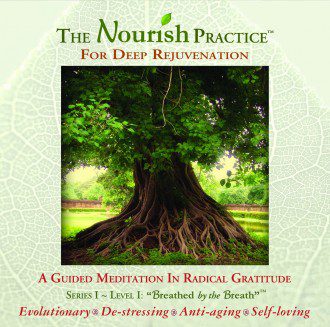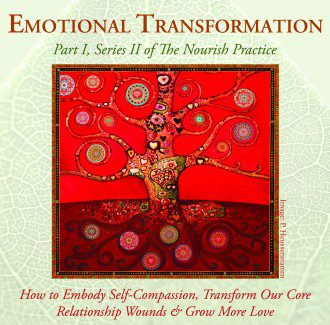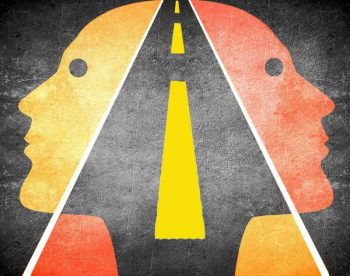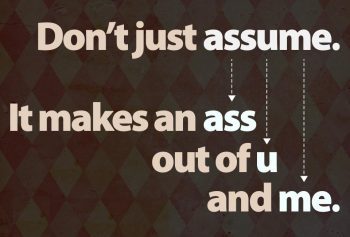1st June, 2017
Contributing writer for Wake Up World
Does someone in your life regularly attack or judge you before getting the story straight? If so, you’re not alone, and know how absurd this kind of interaction is — especially because it’s so preventable!
The single most common source of conflict I encounter on a daily basis is the act of assumption — assuming anything before getting the facts straight. We fail to ask, and instead assume. And when our assumption is negative, we usually engage with a fair amount of emotional baggage, arriving at false conclusions and ingraining false beliefs in our misguided little noggens.
So, when you have an issue with someone, get the facts first. Don’t assume, because how you view that issue will most likely influence your emotions and your actions. When we misinterpret, we might be wrong, and then our whole story, emotional response, and series of actions can be wrong, misplaced, and misguided. This is a kind violence, a going to battle — because of bad thinking. While most of us have been guilty of assumption and going to some battle on false pretenses (think ex-president Bush’s weapons of mass destruction alibi), we don’t have to keep doing it. And we can do less of it. Self-awareness and catching ourselves when we make assumptions is an act of compassion. For, when assumption goes unchecked, scenarios can explode and turn into full-blown wars — among couples, companies, communities, and countries.
[pro_ad_display_adzone id=”110028″]
Assumptions often arise when we feel hurt or threatened by someone else and we can’t handle the feeling we are having. So, we might invent some story about the other person to vilify them, to get back at them, as a way to deal with our hurt feelings. How we (often unconsciously) interpret our feeling, however, might not be accurate. While we might feel unworthy, attacked, or violated, this doesn’t mean that we are or have been. And, in reaction, we might assume the other person doesn’t care about us, is mean and messed up, or anything else we conclude concocted as a reaction to feeling rejected or otherwise hurt.
The first step in this scenario is to try to tolerate hurt feelings. If we can do that, and let them pass, or at least simmer down, without reacting, we stand a better chance to be more reasonable and non-violent. If we can’t handle — if we can’t be with — the feeling, we are more likely to attack and judge, often unconsciously displacing our hurt.
For example, if someone sets a boundary and denies helping you or acquiescing to what you want, you might feel rejected, upset, and hurt. You might then react by blowing them off, telling them off, or otherwise hating on them. Instead, or at least in addition, you could appreciate that they just can’t meet your needs, that their needs are likely not about you, and that they are taking care of themselves. Seen this way, especially if it’s true, you might not only react negatively. You could find yourself appreciating their courage for self-care and honoring of you by telling the truth… and you can sit with your feelings and see what their roots might be.
You might also find that you react because you have a hard time standing up for yourself and setting boundaries; these capacities remain as shadow powers inside you waiting to be enacted so you can better your experience. If true, the other person has provided a great example for you. You can be grateful, and appreciative… if you can own your reaction and disavowed shadow power. This is a prime example of how embracing our dark side (without acting on it) helps us, and how, if we ignore or miss it, we do damage.
So, by pausing before reacting and inquiring into why you are so bothered, you can turn the whole thing around and find upliftment and empowerment when just moments ago rejection, hurt, and anger ruled the stage.
Wood or Snake?
An ancient allegory speaks to the bias and error in our perception and the unpleasant results that arise as a result. The allegory teaches us that when we mistake a piece of wood on the roadside for a snake, we can freak out over nothing. At the same time, not being cautious can cost us our life. So, the lesson is to be aware, to question what we see and how we react. The exception is when we don’t have time to evaluate the danger and must react by default to save our lives, which fear circuitry is built into our nervous system, which is why we startle at the sound or sight of danger. But, in most cases, especially those that don’t truly pack venom, this need not be the case.
The emotions behind assuming, attacking, defending, and denial are often fear, anger, or sadness that can’t be tolerated (and don’t take my word for it, look to see if it’s true in your life). Sometimes we make assumptions as a knee-jerk reaction to feeling threatened. Again, we can catch ourselves in reaction, pause, calm down, and start at the beginning by asking for clarity.
This song by singer-songwriter Melanie Hutton expands the wisdom of the ancient “Wood or Snake” allegory. It is not only catchy but the insightful lyrics speak wisely and poetically to the dynamic of assumptions and misperceptions that “bite us.”
So, make an effort to find out if the wooden “stick” on your path is a snake (or not) before you defend against or attack it. You may be misperceiving, or simply unable to know, the facts. And many times we can’t know the facts until we ask questions. Once you are able to learn the facts, pause again to let your primal emotional response (brain system: amygdala fear response) settle down long enough to receive the knowledge of your conscious awareness (brain system: neocortical rational thinking).
Likewise, when someone asks you a question, be glad they are not assuming and instead asking for information first — unless they phrase the question with a presupposed, implicit assumption, which, unfortunately, is quite common. An example is if your husband asks you, “Why are you always going shopping instead of helping me take care the kids?” First, is it true that you are always going shopping? And second, does your shopping truly neglect the family? Once this is established, the question can be answered more fairly, if it is even valid anymore — because the presuppositions (first and second questions) that prompted the inquiry might not be true.
In truth, hubby might be feeling neglected, frustrated, or resentful. If he is unable to tolerate these emotions and check the facts of his assumptions for truth (i.e., that you always go shopping and you neglect the family), it’s common to resort to blaming and attacking, as in: “Why are you always going shopping instead of helping me take care the kids?”
With this said, we can take this allegory to heart for ourselves: it’s often best not to automatically assume that someone is attacking or trying to trap you when asking a question, even though it might feel this way. Remember, our feelings are not always correct when translated to reality, and our brains are hard-wired to think the worst as a survival mechanism, and it takes cognitive, pre-frontal power to override this impulse to catastrophize.
Sometimes, of course, the stick in our path really is a snake and it’s abundantly clear that someone is coming for us, figuratively or physically. You hear it in their tone, and see it in their body language. In such cases, it’s appropriate to engage defenses (functional ego) to appropriately protect ourselves until a reasonable discourse can happen — take a pause, ask for and take space, engage later with safer, non-violent parameters.
Asking questions before assuming is so infrequent that when people do it, we think something is wrong with the person — we become suspicious just because we’re not used to it! How ironic that a healthy means of communicating is so rare it’s considered strange and cause for alarm! The opposite should be true: that we become alarmed when someone doesn’t ask and assumes — assumes the stick is a snake. And, lastly, when you get a response, pause again before twisting it to match your pre-existing perception of what’s true. For example, when someone responds in a way that challenges what you believe, don’t immediately say, “I know you don’t mean that!” This is cognitive dissonance in action.
“In psychology, cognitive dissonance is the mental stress or discomfort experienced by an individual who a) holds two or more contradictory beliefs, ideas, or values at the same time, b) performs an action that is contradictory to one or more beliefs, ideas or values or c) is confronted by new information that conflicts with existing beliefs, ideas, or values.” (source)
In order not to assume, we have to be emotionally resilient enough to receive new information, because changing our minds means dealing with the fear of what has supported our worldview up to this point. So, let’s now briefly look into the nature of belief, perceived threats to our survival, and what’s needed to change our minds — how to live with and tolerate cognitive dissonance to grow and see reality more clearly.
Cognitive Dissonance
I recently posted on my blog: “Challenge someone’s beliefs and you might as well be holding a gun to their head.” My inquiry into a particular aspect of belief began a few years ago, when I poignantly began noticing the effects of cognitive dissonance and wondering about the tenacity with which we hold onto our beliefs. It seemed that we cling to beliefs as if our lives depend on them!
[pro_ad_display_adzone id=”110030″]
Because of this, I wondered if we perceive, or misperceive, our beliefs to somehow be central to our survival (think religion, purpose in life, business enterprise, or marriage). I learned that through our evolution, beliefs have been intimately tied to our survival. In the spirit of “wood or snake,” consider this statement about the belief of threat in a post by New Scientist:
“A rustle in the undergrowth could be a predator or it could just be the wind, but it pays to err on the side of caution; our ancestors who assumed agency [the power to act] would have survived longer and had more offspring. Likewise, our psychology has evolved to seek out patterns because this was a useful survival strategy.”
Reasonably, this quote ties our tenacity for creating patterns (implicit beliefs about the world) to our physical survival. Rustles in the bushes, predator or not, had to be treated as predators, because a mistake could mean death. The problem is that we have evolved to be fearful of all kinds of things because of this built-in bias to perceive the world as dangerous.
I wonder if we also hold other beliefs, such as those important to our sense of self, as vital to our physical survival, when they in fact are not nearly as crucial as those about lurking predators ready to pounce on us? Such beliefs could include religious beliefs, beliefs about our purpose in life, and beliefs about our relationships. This might explain why cognitive dissonance is so prevalent. If our worldview changes, or is challenged, we feel like we, or part of us, will fall apart and literally die. So, we defend our ideas and beliefs with great vehemence to remain in denial, or comfortably numb, though we may passionately promote our mistakes.
It takes consciously recognizing that we likely are not going to die, or fall apart utterly, if our worldview changes, or needs updating. Part of us might metaphorically die: the part of us that has been operating according to wrong information or wrong perception. We might go through a tough time adjusting to a new reality, but in most cases we are not going to die. Indeed, this knee-jerk reaction to reject cognitive dissonance — whereas accepting cognitive dissonance is to tolerate the discomfort of entertaining new information long enough to reasonably consider its validity, which is a healthy response — and cling to existing beliefs might be another left-over, built-in anxiety to protect us even though we no longer need (all) our beliefs to be so intimately tied to survival.
For example, intolerance for cognitive dissonance can show up when we simply refuse to admit that we are wrong, or even unknowing. Ironically, when our defensive ego takes a blow, we usually survive it, maybe even thrive a little more as a result. But if we cling to fending off information that is contrary to what our fearful selves hold true, then we curtail our thriving. Remember, the ability and mettle to be with difficult feeling states allows us to tolerate taking in new information in the face of the internal disruption the new information causes.
Said another way, emotional resilience is key to successfully resisting challenges to our worldview. Why? As mentioned, underneath resistance and the apparently rational defense of a position, is fear. To not attack and defend means we have to tolerate, to be with, our fear. The more we experience not defending, allow our defensive ego to let up some, find that we are still largely in tact, and ultimately better off, the more we can learn and grow and expand our horizons and update our worldview.
Ultimately, we learn that we can do all of this, if we want to. And, seeing the benefit of doing this, as well as the pitfalls of caving into resisting cognitive dissonance, inspires us to want to. We can live with cognitive dissonance (holding in awareness two or more apparently conflicting beliefs) through distress tolerance (tolerating discomfort without having to react, fix, or go black and white). Most importantly, we learn that war is often avoidable, that more harmony and humility is possible, that we are stronger than we imagine, and less divisive than we think we have to be.
In Sum
So, we can boil it down like this: Ask before assuming you know what’s true. Pause, respond, and inquire before assuming someone is out to get you. Listen and give fair hearing to what you receive in response. And, when in doubt, pause and sit with it. Because the real danger often lies not in our initial perceptions, but in a) how we react to protect what doesn’t need to be defended as vehemently as our fear seems to indicate, and b) the conflict and cementing of opposition and attendant misconstrued beliefs that result. By not assuming that harmless pieces of wood on the road are deadly snakes we save ourselves and others a lot of grief — and can maybe even save the world (yeah, it goes that far).
The Nourish Practice

Jack Adam Weber’s “The Nourish Practice” is an easy, guided meditation-Qi Gong practice in radical gratitude and self-love. It is an Earth-based, body-centered practice — at once physiological and mythological — that is deeply relaxing and replenishing, especially for modern-day burn-out syndrome, and requires little physical effort. “The Nourish Practice” resets your nervous system and fosters a rich inner life.

You can purchase The Nourish Practice as a CD or Digital Download here.
The first installment in Jack Adam Weber’s new “Emotional Transformation” series, entitled “Healing from Heartbreak”, is also available here — a valuable guide to embodying self-compassion, healing and love.
About the author:
 Jack Adam Weber, L.Ac. is a Chinese medicine physician, author, celebrated poet, organic farmer, and activist for body-centered spirituality. He is also the creator of The Nourish Practice, an Earth-based rejuvenation meditation, and Healing from Heartbreak, the first installment in his “Emotional Transformation” series.
Jack Adam Weber, L.Ac. is a Chinese medicine physician, author, celebrated poet, organic farmer, and activist for body-centered spirituality. He is also the creator of The Nourish Practice, an Earth-based rejuvenation meditation, and Healing from Heartbreak, the first installment in his “Emotional Transformation” series.
Weber is available by phone or online for medical consultations and life-coaching.
You can connect with Jack at:
- Website: JackAdamWeber.com
- Facebook: Facebook.com/JackAdamWeber
- Twitter: Twitter.com/JackAdamWeber
- Email: [email protected]
Recommended articles by Jack Adam Weber:
- BREAKTHROUGH — Now Is Our Time
- The Modern Shaman: Fierce Love at the Frontier of Madness
- When We Love an Addict – Courage and the Limits of Compassion
- Arrogance in Relationships: How to Deal With and Heal It
- 11 Reasons Why Hippies (Not Psychos) Should Rule the World
- ReVOLUTION: When Enough is Enough
- Sex – Truth and Dare, Pleasure and Purpose
- Relationships: The Costs of Staying When We Should Leave
- Yin Yang — Ancient Wisdom for Personal and Planetary Transformation
- Heartbreak – Loving Ourselves Through Difficult Times
- SELF-HONESTY: Where All Healing Begins
[pro_ad_display_adzone id=”110027″]








